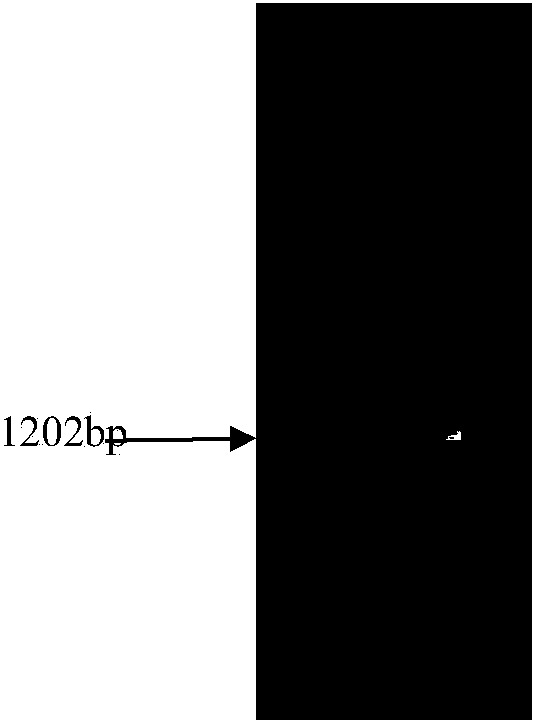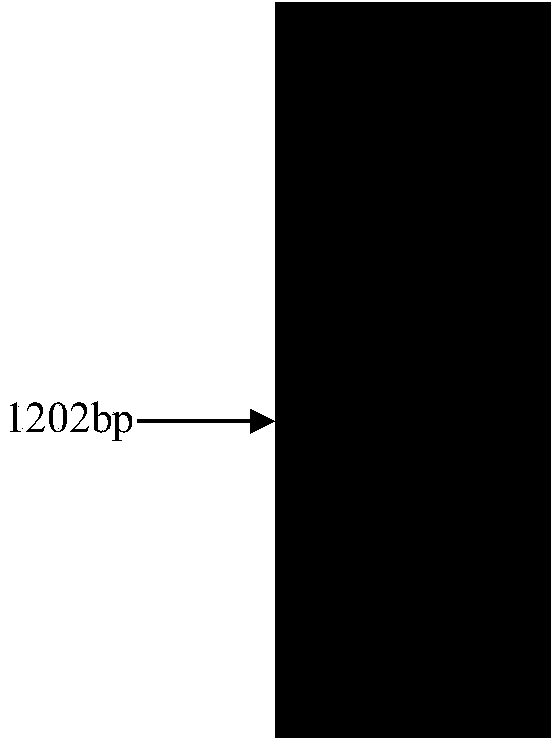Aphis gossypii gossypol-induced CYP6J1 promoter and activity analysis
A technology of CYP6J1 and cotton aphid gossypol, which is applied in the field of bioengineering and can solve problems such as lack of cotton aphid promoter
- Summary
- Abstract
- Description
- Claims
- Application Information
AI Technical Summary
Problems solved by technology
Method used
Image
Examples
Embodiment 1
[0024] Example 1: Cloning of the cotton aphid CYP6J1 promoter
[0025] Chromosome walking primers GSP1 (5-TCATCAAATACTATTCCACGGTTGGGA-3) and GSP2 (5-GCTTTTGAAACTGATAGAAACCGACGAAC-3) were designed according to the CYP6J1 mRNA sequence of cotton aphid (Genbank No. JN989967). Genomic DNA of green peach aphid ( figure 1 ), and digested with straight cutting enzymes AfeI, EcoRV-HF, PvuII, SmaI, PmeI, StuI, purified DNA and ligated adapter primers. PCR amplification was carried out according to the designed specific primers, and the amplification was carried out according to the Genome walker (Clontech) PCR method. The target fragment was amplified and analyzed by 1% agarose gel electrophoresis, and a band with a length of 1202bp was amplified ( figure 2 ), and recycle. The recovered fragment was ligated with the pGEM-T vector to obtain a recombinant plasmid, which was extracted and verified by enzyme digestion ( image 3 ), and sequenced.
[0026] Cotton aphid CYP6J1 promoter...
Embodiment 2
[0030] Example 2: Construction of the cotton aphid CYP6J1 promoter expression vector pGL3-CYP6J1(-848 / +297)
[0031] The cotton aphid CYP6J1 promoter and 5' untranslated region (see sequence listing) cloned in Example 1 were inserted into the pGL3 vector, thereby constructing the pGL3-CYP6J1(-848 / +297) vector.
[0032] More specifically, the promoter sequence was amplified using primers (5-ACGCGTGACTTCTGCCTCAAAGAAG-3, 5-CTCGAGTTTAGTTACCTCCTTAGTAT-3) and cloned into the pGL3 vector MluI and XhoI sites to construct pGL3-CYP6J1(-848 / +297 ), used to drive the expression of Luc+, identified by PCR ( Figure 4 ) and enzyme digestion identification ( Figure 5 ) to obtain the recombinant plasmid of the promoter and the vector.
Embodiment 3
[0033] Example 3: Identification of the activity of the cotton aphid CYP6J1 promoter of the present invention
[0034] Sf9 cells were seeded in 24-well plates (4×105 cells / well), and were transiently co-transfected with pGL3-CYP6CY3(-2230 / +71) construct (2 μg / well) and control with Cellfectin II reagent (Invitrogen; 2 μL / well). Reporter plasmid phRL-TK (Promega; 0.2 μg / well), . After 48 hours, cells were harvested and the resulting lysates were used to measure luciferase activity (Promega). Such as Figure 6 As shown, the cells transfected with pGL3-CYP6J1(-848 / +297) have very high luciferase activity.
PUM
 Login to View More
Login to View More Abstract
Description
Claims
Application Information
 Login to View More
Login to View More - R&D
- Intellectual Property
- Life Sciences
- Materials
- Tech Scout
- Unparalleled Data Quality
- Higher Quality Content
- 60% Fewer Hallucinations
Browse by: Latest US Patents, China's latest patents, Technical Efficacy Thesaurus, Application Domain, Technology Topic, Popular Technical Reports.
© 2025 PatSnap. All rights reserved.Legal|Privacy policy|Modern Slavery Act Transparency Statement|Sitemap|About US| Contact US: help@patsnap.com



